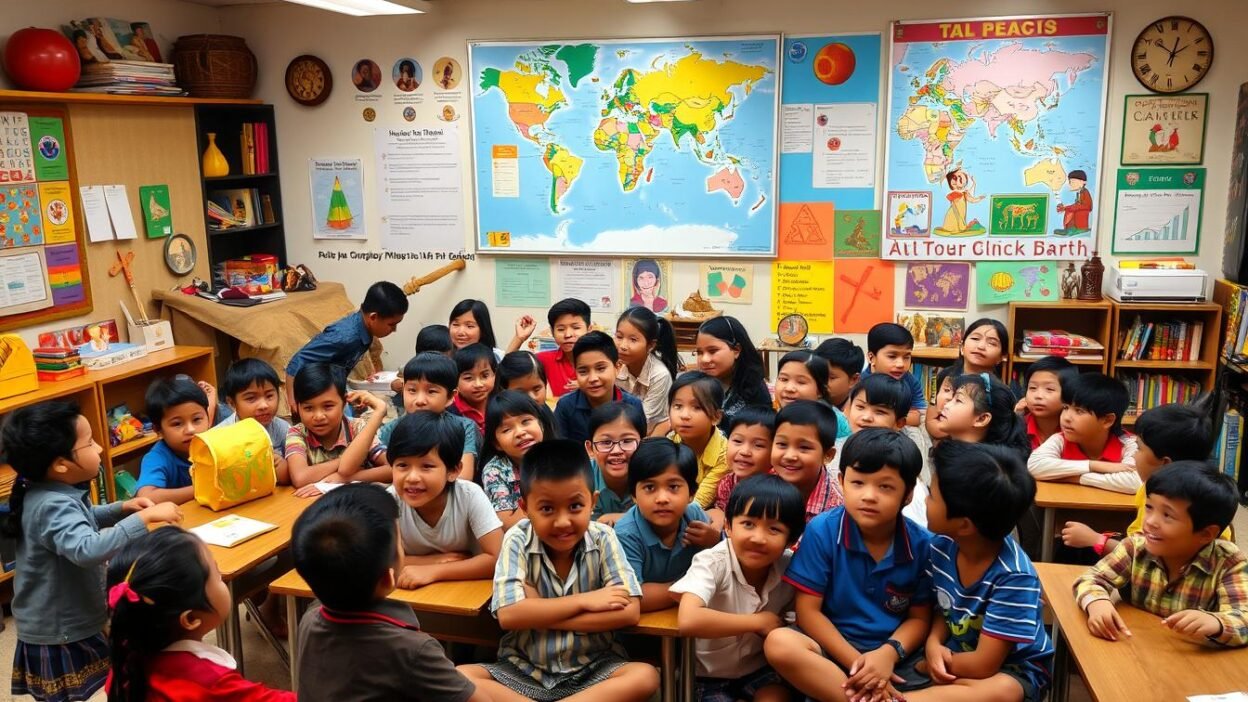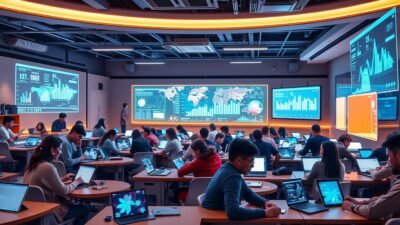Students exposed to diverse cultural perspectives are 42% more likely to develop critical thinking skills. This statistic highlights inter-cultural communication’s power in shaping modern education. In India’s diverse classrooms, bridging cultural gaps is crucial.
Inter-cultural communication fosters understanding and respect among students from varied backgrounds. Educators can create an inclusive atmosphere by embracing cultural sensitivity. This approach enriches learning and prepares students for the global workforce.
Cross-cultural understanding goes beyond language exchange. It includes interpreting gestures, customs, and social norms. Inter-cultural communication transforms learning environments and helps overcome barriers.
Diverse classrooms offer unique opportunities for growth. They allow students to explore different perspectives and broaden their worldviews. This exposure builds empathy and collaboration skills.
Preparing for the UGC NET exam can be a daunting task, but with the right resources, candidates can navigate the process effectively. Websites like MyJRF provide a comprehensive platform for aspiring educators, offering specialized guidance for UGC NET Paper 2 preparation and essential tips for acing UGC NET Paper 1. Additionally, understanding the revised syllabus provided by UGC is crucial for a targeted study approach. For official announcements and updates, candidates should regularly visit the UGC NET NTA portal, while the UGC’s job section and the main UGC website are invaluable for post-exam opportunities and academic resources. With these tools, candidates can maximize their preparation and set themselves up for success.
Key Takeaways
- Inter-cultural communication boosts critical thinking skills
- Diverse classrooms foster inclusive learning environments
- Cultural sensitivity prepares students for global workplaces
- Effective communication bridges cultural gaps in education
- Understanding non-verbal cues enhances cross-cultural interactions
Understanding Inter-Cultural Communication
Inter-cultural communication bridges diverse worlds. It’s vital for exchanging ideas across cultural lines. This skill shines in educational settings where different backgrounds meet.
Definition and Importance
Inter-cultural communication is sharing info between diverse cultures. It builds understanding in multicultural classrooms. This practice creates a rich learning space where students feel valued.
Key Components of Communication
Successful inter-cultural communication needs several key elements:
- Verbal and non-verbal cues
- Active listening
- Empathy and respect
- Cultural awareness
These parts form the base of intercultural competence. Mastering these skills helps navigate cultural differences smoothly.
Barriers to Effective Communication
Obstacles can block good communication across cultures. Common hurdles include:
| Barrier | Impact | Solution |
|---|---|---|
| Language differences | Misunderstandings | Use simple language, visual aids |
| Stereotypes | Prejudice, discrimination | Promote cultural education |
| Nonverbal misinterpretations | Confusion, offense | Learn cultural gestures |
Spotting these barriers is key to beating them. Growing intercultural skills helps create inclusive learning spaces. These spaces celebrate diversity and build mutual understanding.
The Role of Culture in Communication
Culture molds our communication style. It affects our words, gestures, and how we interpret messages. Understanding cultural nuances is vital for effective cross-cultural interactions.
Cultural Dimensions Theory
Geert Hofstede’s theory provides insights into cultural differences. It explores six dimensions, including power distance and individualism. These dimensions help explain varied communication styles across cultures.
Implicit vs. Explicit Communication
Communication styles range from implicit to explicit. High-context cultures rely on nonverbal cues and shared understanding. Low-context cultures prefer direct, clear messages.
Recognizing these differences is crucial in diversity training programs. It helps bridge communication gaps between different cultural groups.
Cultural Norms and Values
Cultural norms deeply influence communication. They shape expectations, taboos, and appropriate behaviors. Awareness of these norms is key to building rapport.
Understanding cultural norms helps avoid misunderstandings in global communication. It fosters respect and smooth interactions across diverse groups.
| Cultural Aspect | Impact on Communication |
|---|---|
| Collectivism vs. Individualism | Group harmony vs. personal expression |
| Time Orientation | Punctuality and scheduling preferences |
| Hierarchy | Formal vs. informal communication styles |
Grasping these cultural elements boosts global communication skills. It nurtures empathy and reduces conflicts in diverse settings. Effective diversity training includes these cultural insights.
This knowledge prepares individuals for successful cross-cultural interactions. It promotes understanding and collaboration across different cultures.
Impact on Educational Settings in India
India’s diverse culture shapes its schools. Institutions are adopting multicultural strategies for inclusive learning. This fosters understanding among students from various backgrounds.
Schools and universities create welcoming spaces. Students learn to respect different cultures. This approach builds a more harmonious educational environment.
Promoting Inclusivity in Classrooms
Teachers in India use new methods for inclusivity. They encourage students to share cultural experiences. This creates a rich mix of perspectives.
Cultural exchange days are popular. Students showcase traditions through food, dress, and performances. These events help bridge cultural gaps.
Case Studies of Diverse Classrooms
A Delhi school paired students from different states. This improved cultural sensitivity and language skills. Students learned from each other’s backgrounds.
In Mumbai, a university started multilingual discussion groups. This enhanced cross-cultural dialogue. Students gained a deeper understanding of different viewpoints.
| School Location | Initiative | Outcome |
|---|---|---|
| Delhi | Buddy System | Improved cultural sensitivity |
| Mumbai | Multilingual Groups | Enhanced cross-cultural dialogue |
Teacher Training and Development
Educators are vital for multicultural communication. Many schools offer training in cultural sensitivity. These programs help teachers address diverse learning needs.
Workshops equip teachers with inclusive tools. They learn to create welcoming environments. This approach benefits all students in the classroom.
“Our training program has transformed how teachers approach cultural diversity in classrooms. They now see differences as strengths, not challenges,” says a leading education expert from Bangalore.
Benefits of Effective Inter-Cultural Communication
Cross-cultural understanding brings many benefits to educational settings. It creates a rich learning environment. Students thrive both academically and socially in this atmosphere.
Enhanced Student Engagement
Students engage more when they feel understood and valued. This leads to deeper learning experiences. Knowledge retention improves with increased participation.
Strengthened Social Networks
Inter-cultural skills help students build diverse friendships. These connections expose them to different perspectives. Students become better prepared for a global workforce.
Improved Academic Performance
Students skilled in cross-cultural communication often excel academically. They develop critical thinking skills. This comes from considering multiple viewpoints and problem-solving approaches.
| Benefit | Impact on Students | Long-term Advantage |
|---|---|---|
| Enhanced Engagement | Active class participation | Improved learning outcomes |
| Stronger Social Networks | Diverse friendships | Global workforce readiness |
| Better Academic Performance | Higher grades | Advanced critical thinking skills |
Educators create an inclusive environment by promoting cross-cultural understanding. This approach benefits all students. It enhances learning and prepares students for our interconnected world.
Strategies for Effective Communication
Effective communication builds intercultural competence in diverse learning environments. This section explores techniques to enhance understanding across cultures.
Active Listening Techniques
Active listening is crucial for successful intercultural exchanges. It involves focusing on the speaker and understanding their message. Educators can practice this by maintaining eye contact and paraphrasing to confirm understanding.
Non-Verbal Communication Cues
Non-verbal cues differ across cultures. Gestures, facial expressions, and personal space preferences can convey various meanings. Diversity training helps recognize these signals to avoid misunderstandings.
| Non-Verbal Cue | Western Interpretation | Eastern Interpretation |
|---|---|---|
| Direct eye contact | Attentiveness, honesty | Disrespectful, challenging |
| Nodding | Agreement | Acknowledgment of listening |
| Thumbs up | Approval | Offensive in some countries |
Conflict Resolution Strategies
Cultural differences can cause misunderstandings. Effective conflict resolution involves finding the root cause and practicing empathy. Educators can use role-playing to develop these skills in the classroom.
“In the realm of intercultural communication, understanding precedes resolution.”
These strategies help create an inclusive learning environment. They foster intercultural competence among students from diverse backgrounds.
Inter-Cultural Communication in Virtual Learning
Virtual learning has revolutionized global communication. It opens doors to multicultural exchanges. This shift brings new challenges and opportunities for educators and students.
Challenges of Online Learning Environments
Virtual classrooms face hurdles in fostering effective multicultural communication. Time zones, tech issues, and limited non-verbal cues can hinder understanding. Cultural norms around online etiquette vary widely.
Tools for Facilitating Communication
Many digital platforms support global communication in virtual learning. Video conferencing enables face-to-face interactions across distances. Chat functions allow for asynchronous exchanges.
Translation software helps bridge language gaps. These tools enhance multicultural communication strategies in online learning environments.
Best Practices for Virtual Classrooms
Creating inclusive virtual learning spaces requires thoughtful approaches. Educators should consider several key strategies.
- Set clear expectations for online behavior
- Use diverse teaching methods to engage various learning styles
- Encourage student participation through polls and breakout rooms
- Provide materials in multiple formats to accommodate different needs
These practices foster a rich learning environment. They celebrate cultural diversity and promote effective global communication. Virtual settings can become spaces of growth and understanding.
Role of Technology in Inter-Cultural Learning
Technology bridges cultural gaps in educational settings. Digital tools connect students and educators across borders. This fosters cultural sensitivity and understanding.
Digital Platforms for Collaboration
Online platforms enable diverse students to work on projects together. They share ideas and learn from each other’s perspectives. Virtual classrooms and video tools create spaces for real-time interactions.
Language Translation Tools
Translation technology overcomes language barriers in multicultural learning environments. These tools help students and teachers communicate across languages. This promotes inclusive education and cultural exchange.
| Translation Tool | Features | Benefits for Inter-Cultural Learning |
|---|---|---|
| Google Translate | Text, voice, and image translation | Instant communication across languages |
| Microsoft Translator | Real-time conversation translation | Facilitates group discussions in multilingual classrooms |
| DeepL | AI-powered accurate translations | Improves understanding of complex academic texts |
Social Media as a Learning Tool
Social media offers unique inter-cultural learning opportunities. Students can connect with peers worldwide and join global interest groups. These interactions foster cultural sensitivity and broaden perspectives.
“Technology in education is not just about devices; it’s about creating global classrooms where students learn to appreciate diversity and develop cross-cultural competencies.”
Educators can create diverse learning environments using these tools. This prepares students for a globalized world. Technology enhances learning experiences and promotes cultural understanding among students.
Developing Cultural Intelligence
Cultural intelligence is vital in today’s diverse educational landscape. It helps educators create inclusive learning environments. This fosters cross-cultural understanding and promotes intercultural competence.
The Importance of Cultural Awareness
Cultural awareness is key to effective teaching in multicultural classrooms. It helps educators recognize and respect diverse perspectives. This enables them to tailor teaching methods for all students.
Steps to Build Cultural Competence
Building cultural competence requires dedication and practice. Here are key steps educators can take:
- Self-reflection: Examine personal biases and cultural assumptions
- Active learning: Engage with diverse cultures through books, films, and personal interactions
- Open dialogue: Encourage discussions about cultural differences in the classroom
- Adaptability: Adjust teaching strategies to accommodate various cultural learning styles
Training Programs for Educators
Many Indian institutions offer specialized training to boost educators’ cultural intelligence. These programs focus on developing cross-cultural communication skills. They also aim to build intercultural competence.
“Cultural intelligence training has transformed my teaching approach. I now see diversity as a strength in my classroom.” – Dr. Priya Sharma, Delhi University
Investing in cultural intelligence creates more inclusive learning environments. This prepares students for success in our globalized world. Educators can make a significant impact through this approach.
Success Stories from Indian Educational Institutions
Indian schools and universities are making great strides in cross-cultural communication. Their success stories highlight the impact of diversity training and intercultural understanding in education.
Highlights from Schools and Universities
Delhi Public School started a cultural exchange program pairing students from different regions. This initiative boosted cultural awareness and created friendships across diverse backgrounds.
At the university level, IIT Bombay’s “Global Connect” project connects students with international peers. They work together on collaborative projects, enhancing their global perspective.
Lessons Learned and Future Directions
These programs show the value of hands-on experience in building cultural competence. Future plans include expanding virtual exchanges and adding more local languages to curricula.
Educators emphasize the need for ongoing diversity training. This helps keep pace with India’s ever-changing cultural landscape.
| Institution | Initiative | Impact |
|---|---|---|
| Delhi Public School | Cultural Exchange Program | Increased cultural awareness, new friendships |
| IIT Bombay | Global Connect Project | Enhanced international collaboration skills |
| Symbiosis International University | Multicultural Festivals | Improved campus inclusivity |
Testimonials from Students and Educators
A Delhi Public School student says, “The exchange program opened my eyes to new perspectives. I’m now more confident talking to people from different backgrounds.”
An IIT Bombay professor notes, “Our Global Connect project has greatly improved our students’ teamwork skills. This is crucial in today’s global workplace.”
“Diversity training has transformed our campus culture. Students and faculty alike are more aware and respectful of cultural differences,” says the principal of Symbiosis International University.
The Future of Inter-Cultural Communication in Education
Education is evolving rapidly. Global and multicultural communication strategies are now crucial. New trends are shaping inter-cultural learning approaches.
Emerging Trends and Innovations
Virtual and augmented reality transform cross-cultural experiences in classrooms. Students explore different cultures without leaving their seats. AI-powered translation tools break down language barriers.
These tools enable real-time communication between students from diverse backgrounds. They create immersive cultural experiences right in the classroom.
Policy Recommendations for Educators
Educators need support to foster effective multicultural communication strategies. Schools should implement policies that enhance cultural understanding.
- Mandate cultural sensitivity training for all staff
- Encourage student exchange programs
- Integrate global perspectives into curricula
Global Collaboration in Learning
The future of education centers on global collaboration. Online platforms connect classrooms across continents. Students work together on projects, bridging cultural divides.
This approach enhances understanding of different cultures. It prepares students for an interconnected world beyond the classroom.
“Education is the most powerful weapon which you can use to change the world.” – Nelson Mandela
These changes in education foster a more inclusive society. They build understanding and connections, starting right in our classrooms.
Conclusion: Embracing Diversity in Education
Embracing diversity in education is a necessity, not just a trend. Cultural sensitivity shapes inclusive learning environments. By fostering cross-cultural understanding, we prepare students for success in our interconnected world.
The Long-Term Impact on Society
Effective inter-cultural communication has far-reaching effects beyond the classroom. Students who appreciate cultural differences become ambassadors for tolerance and cooperation. These skills are crucial for building a harmonious society where diverse perspectives are valued.
A Call to Action for Educators and Administrators
Creating inclusive learning spaces is the responsibility of educators and administrators. It’s time to implement practical strategies for enhancing cross-cultural understanding. This may involve updating curricula, providing targeted training, or using technology to connect students globally.
By prioritizing inter-cultural communication, we invest in a brighter future for all. This approach fosters unity and prepares students for a diverse world. It’s a crucial step towards building a more inclusive and understanding society.
FAQ
What is inter-cultural communication in education?
Inter-cultural communication in education involves exchanging ideas between people from different cultures in learning settings. It requires developing cultural sensitivity to interact effectively across diverse contexts. This approach enhances the overall educational experience for students and teachers alike.
Why is inter-cultural communication important in learning environments?
Inter-cultural communication fosters inclusivity and prepares students for a global workforce. It enhances student engagement and improves academic performance. This approach also breaks down cultural barriers and promotes understanding among diverse student populations.
What are some common barriers to effective inter-cultural communication?
Language differences and cultural stereotypes often hinder effective inter-cultural communication. Ethnocentrism and misinterpretations of non-verbal cues can also cause problems. Varying communication styles and differing cultural norms present additional challenges.
Overcoming these barriers requires cultural awareness, empathy, and a willingness to adapt.
How can educators promote inclusivity in diverse classrooms?
Educators can use multicultural communication strategies to promote inclusivity. They should foster a respectful learning environment and include diverse perspectives in the curriculum. Encouraging cross-cultural dialogue and collaborative learning among students from different backgrounds is also effective.
What is Cultural Dimensions Theory, and how does it relate to communication?
Cultural Dimensions Theory, developed by Geert Hofstede, describes national cultures along six dimensions. These include Power Distance, Individualism vs. Collectivism, and Masculinity vs. Femininity. The theory also covers Uncertainty Avoidance, Long-Term vs. Short-Term Orientation, and Indulgence vs. Restraint.
This framework helps understand how cultural differences impact communication styles in educational settings.
What strategies can be used for effective inter-cultural communication?
Effective strategies include active listening and being aware of non-verbal cues. Practicing empathy and developing cultural intelligence are crucial. Using clear language, being patient, and employing culturally-sensitive conflict resolution strategies also help.
How does technology facilitate inter-cultural learning?
Technology bridges cultural gaps through digital collaboration platforms and translation tools. It enables real-time communication across borders and provides access to diverse perspectives. These tools create opportunities for global teamwork in virtual learning environments.
What is cultural intelligence, and how can it be developed?
Cultural intelligence (CQ) is the ability to work effectively across cultures. It can be developed by increasing cultural awareness and engaging in cross-cultural experiences. Learning about different cultures, practicing empathy, and participating in diversity training also boost CQ.
What are some challenges of inter-cultural communication in virtual learning environments?
Virtual learning environments face challenges like time zone differences and technological barriers. Reduced non-verbal cues and cultural misunderstandings in written communication are common issues. Varying levels of digital literacy and difficulties in building online trust also pose problems.
How can educational institutions in India implement effective inter-cultural communication strategies?
Indian educational institutions can provide diversity training for educators. They should incorporate multicultural perspectives into curricula and foster international collaborations. Creating inclusive policies and encouraging student exchange programs are effective strategies. Using technology to connect with global communities also helps.





